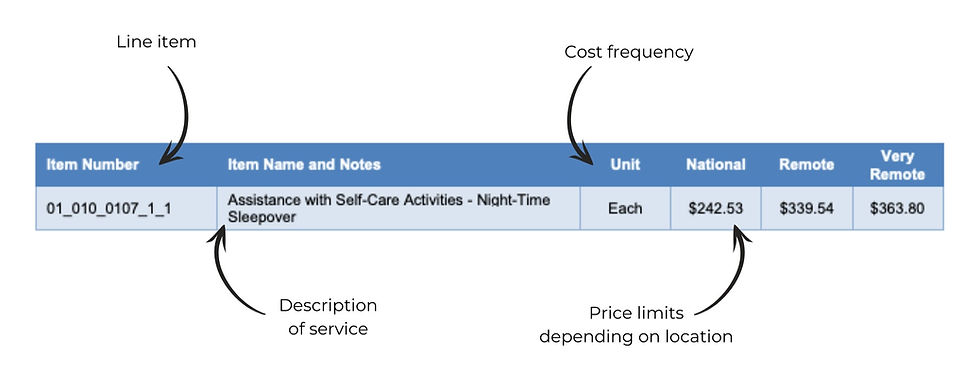How to Navigate the NDIS Pricing Arrangements & Price Limits
- First2Care Team
- Jan 26, 2022
- 3 min read
The NDIS Pricing Arrangements and Price Limits (formerly the NDIS Price Guide), is a guide that provides NDIS participants with an overview of how they can use their funding as well as the price limits on services that a service provider can charge. Although this guide is incredibly helpful and important for NDIS participants, there are a lot of pages (we’re talking 100+) and often the language used is complex. To make things easier, let’s breakdown how to read, understand, and navigate the NDIS Pricing Arrangements & Price Limits with confidence.

What is the Pricing Arrangements & Price Limits?
The Pricing Arrangements & Price Limits is released every financial year to reflect the new market cost of services. Although the guide is released annually, there are circumstances where updates may be required (like with Covid-19). When this occurs, the guide is updated online and the NDIS will release a statement on their website notifying of any changes.
The guide outlines the pricing for supports, how providers should invoice, price limits, if a quote is required, and any rules and regulations that apply for the year ahead. The guide contains plenty of useful information around what you might be able to claim using your NDIS funding and what category you can claim under.
How to use the Pricing Arrangements & Price Limits
There are hundreds of kinds of supports and descriptions listed in the guide. So, in order to navigate the guide easily you’ll first need to understand how the NDIS categorises supports.
The NDIS categorises supports into ‘Support Purposes’, ‘Support Categories’, and ‘Support Items’
Support Purposes
Your Support Purposes are divided into:
Core supports: your main support category which helps with everyday activities, and to access and participate within your community
Capital Supports: covers Assistive Technology and Home Modification
Capacity Building Supports: designed to help build skills and independence in your daily life, and to help you pursue your goals
Support Categories
Support categories further breakdown your Support Purposes – Core, Capital and Capacity Building Supports.
Your Core supports is divided into four main categories. They are:
Assistance with Daily Life
Consumables
Assistance with Social and Community Participation
Transport
Your Capital supports is divided into two main categories. They are:
Assistive Technology
Home Modifications
Your Capacity Building Supports are divided into eight categories. They are:
Improved Living Arrangements (or ‘CB Home Living’)
Increased Social and Community Participation (or ‘CB Social Community and Civic Participation’)
Finding and Keeping a Job (or ‘CB Employment’)
Improved Relationships (or ‘CB Relationships’)
Improved Health and Wellbeing (or ‘CB Health and Wellbeing’)
Improved Learning (or ‘CB Lifelong Learning’)
Improved Choices (or CB Choice and Control)
Improved Daily Living (or CB Daily Activity)
Support Items
Each support that a provider supplies to a participant can be classified as one of the support items listed in guide. Providers claim payments against the support item that aligns to the service they have delivered.
Support item example:

It specifies the item number (or line item), the item name and notes, the unit (or how frequently it is charged i.e., each, hour, daily, week, month, and annual), and then the pricing limits for national, remote, and very remote areas.
Now that you know how the NDIS categorises supports, all you need to do is:
Go to the table of contents
Find support purpose and support category (i.e., Core Support, Assistance with Daily Life)
Review the different options underneath the support category and find the most relevant to you
Go to the corresponding page number
Review the description of that support and the pricing limits.


What is a line item?
Essentially every support service that you receive will have a line item, or to put it simply – a code, attached to it. This code is then used by your service providers on your invoices to show the NDIA what support service they provided and by the NDIA to determine which of your support budgets pays for the support.
What if a support fits into more than one line item?
Some NDIS supports may fall under different support categories (Core, Capital, Capacity Building) and line items. If this is the case, always choose the relevant line item from either your Capital or Capacity Building Support budget before choosing a line item under Core Supports. The reason for this is because both Capital and Capacity Building Supports are typically not flexible, whereas your Core Supports budget is flexible.
If you no longer have funding available in your Capital or Capacity Building Support budget, then you could use your Core Support budget.
The NDIS Pricing Arrangements and Price Limits can be a little confusing and overwhelming. If you need help to better understand how the guide works, you can contact your Support Coordinator, your Local Area Coordinator (LAC) or our support team.
Read more about the benefits of working with an independent, professional Plan Manager. Alternatively, contact our friendly team on 1300 322 273 or support@first2care.com.au.
